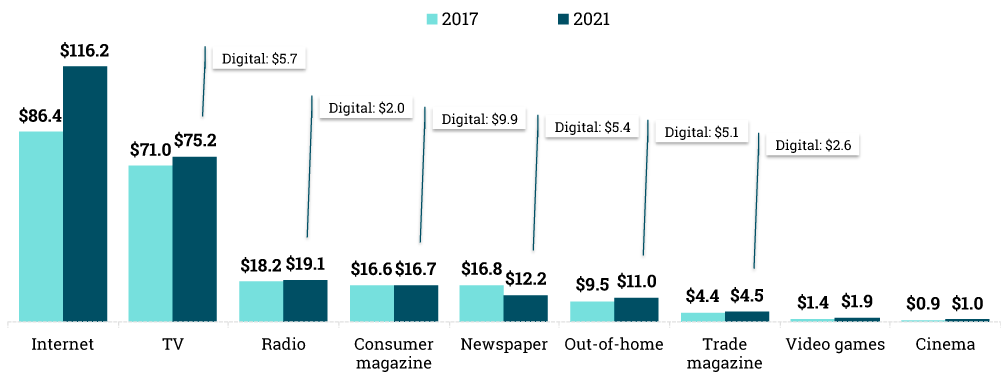The saying, “what happens offline stays offline” is no more. Marketers can now use attribution to measure the influence of offline ads against online sales, and the other way around. The all-round transparency marketers always dreamed of has become a reality.
Offline is less advanced, but not less important
Automated customer journeys and omni-channel cross-device attribution are rapidly becoming the norm. It’s all too easy to forget about the importance of “simple” offline ads when highly advanced, personalized online ads are coming at you from all sides.
But just because the possibilities for measuring offline customer behavior aren’t as advanced as online methods doesn’t make it less important. In terms of ad budget spent, TV and Radio still make up half of the pie, and they will remain popular for years to come, according to this graph from MarketingCharts.
It has always been hard to measure whether offline ads target the correct audience and whether the campaign was effective. But those days are now over.
Yes, we have found a way to bridge the gap between offline and online — making these two channels best friends forever.
Aligning offline and online initiatives
Up until now, there has always been a considerable barrier between online and offline activities. There’s online marketing activities on the one hand, and on the other there’s TV, Radio, Print, Call and Events. Often they are separate teams with different skills and mindsets, and usually in different locales.
Many offline stores don’t even consider advertising online. It is even less common for e-commerce stores to advertise using print or radio.
To maximize revenue, companies need to combine and integrate online activities with offline initiatives. E-commerce stores can win big by advertising offline, while traditional offline stores can increase market share by reaching online audiences.
What happens offline… goes online
Although online sales are rapidly growing, offline sales still make up around 80% to 90% of retail spending. That means that tying online ads to in-store, physical purchases is where the real money can be made. But how? Here are two cases.
#1 Measuring the effect of online ads on offline sales
Using location data is one way marketers can measure the effect of online ads on offline sales. If someone sees an ad for a certain cinema, and the next day their GPS tracker stays at that cinema location for more than 90 minutes, there’s a good chance the ad has done its job. Here’s an in depth article about location tracking for marketing attribution.
Another method to measure the effect of online ads on offline purchases is by simply uploading a file of offline sales using our attribution tool. Purchase volumes in an offline store are matched to the location where online ads were shown. It’s a simple matter of comparing online ad impressions to store purchases in a certain area.
Using LeadsRx, you can also upload a list of new contacts you acquired at a trade show. Or if you’ve made some calls to prospects, you can register those so the system will recognize them the next time they show up on your website. That is how offline meets online.
#2 Measuring the effect of offline ads on online sales
A similar approach can be taken to measure the effectiveness of TV and radio advertisements. LeadsRX registers the exact time a radio or TV spot is aired and measures the lift in online traffic and revenue for a period of time after.
Even if an offline ad doesn’t lead to purchases right away, you can still keep track of your ad’s effectiveness. Even when a specific visitor casually browses your website, then leaves, and comes back to make a purchase a year later, it is still possible to attribute that sale to that initial offline ad you broadcasted a year ago.
The gap between online and offline activities as it has always existed has now been bridged. The effect of online ads on offline sales, and the effect of offline ads on online sales can now be measured.
Start iterating towards perfection
When you know which messages generate revenue and which don’t, you can start to make adjustments. You can start to iterate towards perfection to get the most out of every advertising dollar you spend.
Shopify sellers can create the perfect radio messages by running A/B test with female versus male voices. Your local car dealer can start to craft the perfect Google Adwords banner, experimenting with box sizes, texts and ever more relevant keywords. And even law firms, who traditionally advertise and sell offline, can now monitor the effectiveness of TV, radio and billboard ads using an online attribution tool.
The overview marketers always wanted
In a strange turn of events, advancements in online marketing attribution have now made it possible to measure the effectiveness of offline activities. Marketers can now get the overview of all activities they have dreamt of for decades.
You remember that classic saying about how marketers don’t know which half of their budget they’re wasting? Well, with the marriage of online and offline marketing, they may just be able to find out.


